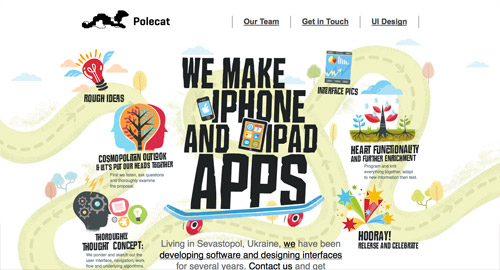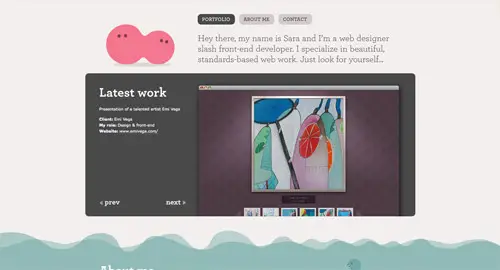Line25 Sites of the Week is a weekly roundup of the most outstanding website designs that I stumble across during my every day browsing. In this week’s collection, we have designs from Lukes Beard, Polecat, Keith Homemade Cakes, Sara Tušar Suhadolc and Pixel Fusion.
Archive for January, 2011
Bill O’Reilly on Science: You Can’t Explain the Tides
 Apparently, Bill O’Reilly has never heard of the moon. In a debate Tuesday with Dave Silverman, head of the American Atheist group behind this , the Fox host tried to prove the existence of God by citing the unknowable mysteries of the tides. “I’ll tell you why [religion is] not a...
Apparently, Bill O’Reilly has never heard of the moon. In a debate Tuesday with Dave Silverman, head of the American Atheist group behind this , the Fox host tried to prove the existence of God by citing the unknowable mysteries of the tides. “I’ll tell you why [religion is] not a... Mike Tyson, pigeon fancier, gets his own TV show – Reuters
Mike Tyson, pigeon fancier, gets his own TV show Reuters Former heavyweight champion Mike Tyson smiles as he gestures at a panel for the Animal Planet documentary ''Taking on Tyson'' during the Discovery Networks ... and more » |
Hackers Find New Way To Cheat On Wall Street
Read more of this story at Slashdot.
The NASA yard sale is awesome [Nasa]
The most epic diaper commercial of all time
Fredrick Bond got together with Mass Market to give Huggies the Philips Carousel treatment. Despite its ironically gratuitous approach, the concept and tag definitely work. You are marketing to parents after all, so why not ditch the cute animated characters and have some fun with the execution.
Client/Product: Huggies Little Movers Diapers
Agency: JWT, New York
Executive Creative Director: Walt Connelly
Creative Director: Richie Glickman
Art Director: David Suarez
Copywriter: Daniel Gonzalez
Head of Art: Aaron Padin
Title Animation: Chadwick Whitehead
Director of Integrated Production: Clair Grupp
Director of Brand Production: Joe Calabrese
Senior Integrated Producer: Owen Katz
Assistant Producer: Mike McLoughlin
Business Director: Karyn Rockwell
Account Executives: Aissatou Balde, Raymond Lynch
Production Company: MJZ
Director: Fredrik Bond
Executive Producer: Lisa Margulis
Senior Executive Producer: Jeff Scruton
Producer: Nicholas Wrathall
DP: Hoyte van Hoytema
Visual Effects and Editorial: MassMarket, New York
Executive Producers: Rich Rama, Justin Lane
Producer: Nancy Nina Hwang
Associate Producers: Marcus Lansdell, Justin Romero
Editor: Cass Vanini
Lead Flame: David Parker
Senior Flame: Jamie Scott
CG Supervisor: Damon Ciarelli
CG Lead: Andy Jones
CG: Todd Akita, Jonah Friedman, Soo Hee Han, Xuan Siefert
CG Modeler: Tom Cushwa
CG Previz: Ian Brauner
Tracking Lead: Joerg Liebold
Tracking: Denis Trutanic
Flame: Joanne Unger
Junior Flame: Jeen Lee, Adam Flynn
Audio Post: JWTwo
Sound Mixer: Andy Green
Music Producer: Dan Burt
Audio Producer: Greg Tiefenbrun
Animation Company: Buck, New York
Executive Producer: Kate Treacy, Anne Skopas
Producer: Kevin Hall
Creative Director: Orion Tait
CG Supervisor: Lars Holmgren
3D Generalist: Kevin Couture, Arvid Volz, Dave Soto
CG Lead/Modeling/Comping: Ryan O’Phelan
To fight spam, Google Apps adds e-mail signing
Originally posted at Deep Tech
MMR Vaccine and Autism: Lies, All Lies
The 1998 paper that linked MMR vaccination with autism has had a long way to fall. It made, of course, a huge media sensation, and energized the whole vaccination/autism controversy that still (in spite of evidence) goes on. But it didn't look very robust from the start, scientifically. And over the years it's gone from "Really needs shoring up" to "hasn't been reproduced" to "looks like there's something wrong with it" to "main conclusions retracted" to the final, lowest level: outright fraud.
Here's a good history of the whole affair in the BMJ. And here's the first part of a series of articles by Brian Deer, the journalist who dug into the study and found how fraudulent it really was. Not one of the 12 cases in Wakefield's original study hold up; the data were manipulated in every single one to make it fit his hypothesis. His hypothesis that he was getting grant money for. His hypothesis that he was already planning lawsuits around, before the study even started.
His hypothesis, I might add, that has led to completely unnecessary suffering among the unvaccinated children this scare has produced over the years, and has diverted enormous amounts of time, energy, and money away from useful study of autism. This sort of deliberate action is really hard to contemplate, as a reasonable human being - it's like some sort of massive campaign to persuade people to throw bricks through the windows of ambulances.
In a better world, we'd be getting expressions of sorrow and contrition from all the celebrities and others who've profited from this business. But that's not going to happen, is it?












